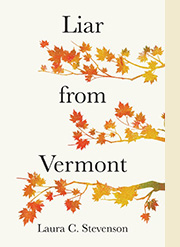A New Series: One Minute Reviews of
Books by Vermont Authors
Laura's column "One Minute Reviews" has appeared bi-weekly in Wilmington, Vermont's Deerfield Valley News since 2015. In April 2018, she found that no Vermont periodical consistently reviews all commercially published fiction and non-fiction by Vermont authors, so she started a series to fill that void. Published reviews from that series and some earlier reviews of local authors are listed with links to a scan of the printed copy. Reviews still in queue are listed without links until they appear in print.
The books reviewed in this series are available through Wilmington's Pettee Memorial Library, the Whitingham Free Public Library, and locally owned Bartleby's Books in Wilmington.
Deerfield Valley News, 11/7/2024
Exploring the intersection of race, class, art
Danzy Senna, Colored Television. Riverhead Books, 2024
Jane, the heroine of Danzy Senna’s Colored Television, is a mixed-race novelist who teaches at a small Los Angeles college. Her tenure decision depends upon her finishing her second novel, on which she has been working for ten years, during the sabbatical that she is presently enjoying. Her husband, Lenny, is a Black painter who teaches at another small Los Angeles college; it pays poorly and does not offer tenure. His paintings are abstract, original—and unsaleable, because he refuses to market himself as a Black artist. The couple’s tenuous artistic positions are reflected in their living style: maxed-out credit cards, minimal social life, and a series of short-term rentals which, however tacky, are uniformly above their price-range, because they need good school districts for their young children.
As the book opens, their situation looks about to change: they are living for a whole year in the house of Jane’s friend Brett, who, having abandoned “that most doomed of genres, literary fiction,” has made a fortune writing for TV, and is spending the year in Australia. Brett’s elegant modern house offers Jane a glimpse of what their life could be like, and she completes the novel at last. Lenny calls it “a mulatto War and Peace”; it’s a 400-page fictional reflection on the experiences of mulattos in American history and society. Proud of her achievement and looking forward to both tenure and royalties, Jane persuades her family to look at a house in a multi-racial, upper middle class Los Angeles neighborhood that Lenny points out they can’t possibly afford. Looking around at the comfortable houses, Jane remembers her father telling her that “Black people didn’t want to be white …They only wanted to have what white people had…Race was always about money, and money was always about race.” The novel explores the intersection of race, class and art in detail.
The editor who published Jane’s previous novel rejects the new one as “Frankensteinian.” Her agent suggests gently that some novels are better left in drawers. The rejection means Jane’s college will demote her and double her teaching load with two classes of freshman composition. In desperation, Jane remembers Brett’s turn from novels to TV, and writes to his agent, suggesting that she could offer a TV series about a mulatto family. The attempt initially seems promising; it leads Jane to creative sessions with Hampton Ford, a hot-shot Black TV producer. Knowing that Lenny hates the commodification of art, she tries to hide her hoped-for metamorphosis from the family, while dreaming of the financial and social results of what Ford tells her might become “The Jackie Robinson” of biracial comedies … if only she (and he) can please the (fabulously wealthy, white) man who would finance the series.
The strength of Colored Television lies not just in its unsparing portrayal of the Los Angeles TV world, but the details of the ambivalent circles in which Jane herself lives. In a poignant early chapter, she gives a birthday party for her daughter, Ruby, in Brett’s house, thus giving her family the upper- middle class aura of Brett’s neighborhood and its school. Stretching her credit card, she gives Ruby an American Girl doll. But at 8 years old, Ruby knows that you’re supposed to have a collection of American Girl dolls, and accessories for all of them. And she’s humiliated because the doll is Black, not one of the more popular white ones her guests have. As for the guests, who are white, she tells Jane they aren’t her friends. “Those are just girls you invited. I don’t know any of them.” This scene, and others like it, portray Jane’s misguided attempts to give her children a secure life with surprising sympathy, even while the book’s acerbic portrayal of Hampton Ford makes it clear that her desire for material things is making her undercut her artistic talent and setting her up for disaster. Senna’s wit is sharp, but her portrayal of temptation and betrayal is, in the end, forgiving.


